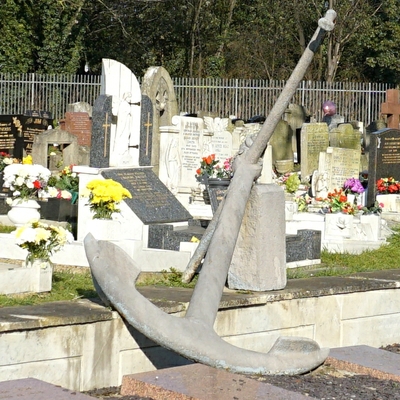Erection date: 1920
{On the front of the plinth:}
To the glory of God and in memory of those from this parish who laid down their lives in the Great War, 1914 - 1918.
{On the back of the plinth: 11 names. On the right side of the plinth: 3 names. See Subjects commemorated for the 14 names:}
Note that the arrangement of the names on the back has been well-designed: they are in alphabetical sequence and fit neatly onto the stone. The names on the side (Shepherd, Phillips and Ford) are in random sequence and space is available below for more names. We suggest that these 3 names were late additions to the memorial, possibly due to their deaths either happening, or only being confirmed, after the designed panel was completed.
The Listing entry gives the date as c.1920 and has "The north side... Names of the Fallen are inscribed on the other faces. The memorial's Roll of Honour was inscribed on the adjoining north wall of the stairs of St John's Church ..." but does not explain why some names are on the plinth of the cross and others are on the wall plaque on the stairs.
Site: St John Horsleydown - WW1 memorial (2 memorials)
SE1, Fair Street, St John's Churchyard
A nearby information board provides:
"In the early 1600s, an Artillery Hall was built nearby and part of Horselydown was used by the Southwark Trainbands (a group of local militia men), who practised archery and exercised arms. The Artillery Hall later became a workhouse for the parish of St John’s. St John’s Church was also granted the lease of the remaining land as a parish burial ground.
"Nicholas Hawksmoor designed the new church, St John’s Horselydown, with John James in the late 1720s and it was completed in 1733. Its most distinctive feature was the spire in the form of a tapering column, topped by a weather vane depicting a comet.
"Much of the church was destroyed by bombs during World War II; by 1956 it had closed, and the land transferred to the then Borough of Bermondsey. The plinth of the Hawksmoor church can still be seen beneath the London City Mission’s 1970s building. {Including the steps that can be seen in our photos.}
"In the early 2000s, Southwark Council renovated the Park and commissioned a public artwork from Gary Breeze. The work consists of historical passages inlaid around the Park; when pieced together, it provides an interesting puzzle of the Park’s history."
Londonist have an excellent post on this park, especially its artwork/puzzle consisting of cut up inscriptions laid into the ground.
The heading on the wall plaque indicates that, at the time that memorial was erected (presumably c. 1920), the parish of Saint Olave and that of Saint John were merged into one parish. We are struggling to explain that.
Wikipedia explains that in 1733, when this church was built, the St John Horsleydown parish was created out of the St Olave parish. The two (religious) parishes remained distinct until 1947 when, St Olave's church having been demolished in 1926, the two parishes remerged, the resultant parish being known as Southwark, St Olave and St John.
In the 19th century the story is complicated by the fact that "civil parishes" (to do with local government) became distinct from religious parishes. So, for completeness, the situation with the civil parishes was: 1855 a civil parish called the St Olave District was created from three existing parishes: St Johns, St Olaves and St Thomas's. In 1900-04 this became the Metropolitan borough of Bermondsey.
So, the two religious parishes were separate entities between 1733 and 1947 which makes explaining the heading line on the wall plaque so difficult. Another question we can't answer: why there are two lists of the fallen: one on the wall plaque and one on the plinth of the cross.
Groping for explanations we note that the St Olave congregation were apparently left church-less for 21 years (1926-1947) which seems odd. Perhaps "1947" is a mistake, maybe "1927" is the correct date of the merger? And, maybe, when WW1 memorials were being considered (only about 6 years before the St Olave church would be demolished) it was already clear that the St Olave parish would be merging with St John, so it was decided to create a single memorial, at St Johns, in two parts: the St Olave list, the smaller one, being on the plinth of the cross, and the longer St John list being on the large plaque?











Comments are provided by Facebook, please ensure you are signed in here to see them